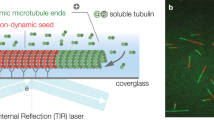Abstract
It has previously been shown that two populations of microtubules coexist in a dynamically unstable manner in vitro: those in one population elongate while those in the other shorten and finally disappear1,2. This conclusion was based on changes in the number and length distribution of microtubules after dilution of the micro-tubule solution. Here, we demonstrate directly that growing and shortening populations coexist in steady-state conditions, by visualization of the dynamic behaviour of individual microtubules in vitro by dark-field microscopy. Real-time video recording reveals that both ends of a microtubule exist in either the growing or the shortening phase and alternate quite frequently between the two phases in a stochastic manner. Moreover, growing and shortening ends can coexist on a single microtubule, one end continuing to grow simultaneously with shortening at the other end. We find no correlation in the phase conversion either among individual microtubules or between the two ends of a single microtubule. The two ends of any given microtubule have remarkably different characteristics; the active end grows faster, alternates in phase more frequently and fluctuates in length to a greater extent than the inactive end. Microtubule-associated proteins (MAPs) suppress the phase conversion and stabilize microtubules in the growing phase.
Similar content being viewed by others
References
Mitchison, T. & Kirschner, M. Nature 312, 232–237 (1984).
Mitchison, T. & Kirschner, M. Nature 312, 237–242 (1984).
Inoue, S. & Sato, H. J. gen. Physiol. 50, 259–292 (1967).
Salmon, E. D., Jeslie, R. J., Saxton, W. M., Karow, M. L. & McIntosh, J. R. J. Cell Biol. 99, 2165–2174 (1984).
Karsenti, E., Newport, J., Hubble, R. & Kirschner, M. W. J. Cell Biol. 98, 1730–1745 (1984).
Summers, L. & Kirschner, M. J. Cell Biol. 83, 205–217 (1979).
Bergen, L. & Borisy, G. J. Cell Biol. 84, 141–150 (1980).
Sloboda, R. D. et al. in Cell Motility (eds Goldman, R., Pollard, T. & Rosenbaum, J.) 1171–1212 (Cold Spring Harbor Laboratory, New York, 1976).
Hill, T. L. & Chen, Y. Proc. natn. Acad. Sci. U.S.A. 81, 5772–5776 (1984).
Carlier, M. F. & Pantaloni, D. Biochemistry 20, 1918–1924 (1981).
Sloboda, R. D., Rudolph, S. A., Rosenbaum, J. L. & Greengard, P. Proc. natn. Acad. Sci. U.S.A. 75, 177–181 (1975).
Hotani, H. J. molec. Biol. 156, 791–806 (1982).
Carlier, M. F., Hill, T. L. & Chen, Y. Proc. natn. Acad. Sci. U.S.A. 81, 771–775 (1984).
Chen, Y. & Hill, T. L. Proc. natn. Acad. Sci. U.S.A. 82, 1131–1135 (1985).
Author information
Authors and Affiliations
Rights and permissions
About this article
Cite this article
Horio, T., Hotani, H. Visualization of the dynamic instability of individual microtubules by dark-field microscopy. Nature 321, 605–607 (1986). https://doi.org/10.1038/321605a0
Received:
Accepted:
Issue Date:
DOI: https://doi.org/10.1038/321605a0
- Springer Nature Limited
This article is cited by
-
Label-free mid-infrared photothermal live-cell imaging beyond video rate
Light: Science & Applications (2023)
-
Tubulin Cytoskeleton in Neurodegenerative Diseases–not Only Primary Tubulinopathies
Cellular and Molecular Neurobiology (2023)
-
Ultrastructural and biochemical classification of pathogenic tau, α-synuclein and TDP-43
Acta Neuropathologica (2022)
-
Planar photonic chips with tailored angular transmission for high-contrast-imaging devices
Nature Communications (2021)
-
Adaptive dynamic range shift (ADRIFT) quantitative phase imaging
Light: Science & Applications (2021)




